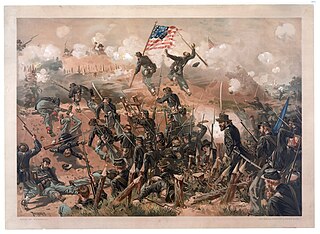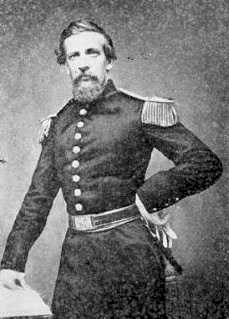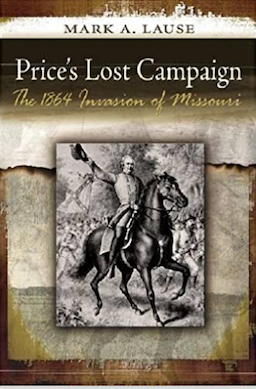
The siege of Vicksburg was the final major military action in the Vicksburg campaign of the American Civil War. In a series of maneuvers, Union Major General Ulysses S. Grant and his Army of the Tennessee crossed the Mississippi River and drove the Confederate Army of Mississippi, led by Lieutenant General John C. Pemberton, into the defensive lines surrounding the fortress city of Vicksburg, Mississippi, leading to the successful siege and Confederate surrender.

The Battle of Big Black River Bridge was fought on May 17, 1863, as part of the Vicksburg Campaign of the American Civil War. During the war, the city of Vicksburg, Mississippi, was a key point on the Mississippi River. On April 30, 1863, a Union army commanded by Major General Ulysses S. Grant began crossing onto the east side of the Mississippi River as part of a campaign against Vicksburg. After engaging and defeating Confederate forces in several intermediate battles, Grant's army defeated Lieutenant General John C. Pemberton's Confederates at the decisive Battle of Champion Hill on May 16. During the retreat from Champion Hill battlefield, one division of Pemberton's army, commanded by Major General William W. Loring, was cut off from Pemberton's main body. Pemberton, retreating westwards towards Vicksburg, did not know the location of Loring's division, and he held a bridgehead on the east side of the Big Black River to cover Loring's anticipated withdrawal across the river on the morning of May 17.

The Battle of Chickasaw Bayou, also called the Battle of Walnut Hills, fought December 26–29, 1862, was the opening engagement of the Vicksburg Campaign during the American Civil War. Confederate forces under Lt. Gen. John C. Pemberton repulsed an advance by Union Maj. Gen. William T. Sherman that was intended to lead to the capture of Vicksburg, Mississippi.

The Battle of Raymond was fought on May 12, 1863, near Raymond, Mississippi, during the Vicksburg campaign of the American Civil War. Initial Union attempts to capture the strategically important Mississippi River city of Vicksburg failed. Beginning in late April 1863, Union Major General Ulysses S. Grant led another try. After crossing the river into Mississippi and winning the Battle of Port Gibson, Grant began moving east, intending to turn back west and attack Vicksburg. A portion of Grant's army consisting of Major General James B. McPherson's 10,000 to 12,000-man XVII Corps moved northeast towards Raymond. The Confederate commander of Vicksburg, Lieutenant General John C. Pemberton, ordered Brigadier General John Gregg and his 3,000 to 4,000-strong brigade from Jackson to Raymond.

John Stevens Bowen was an American career Army officer who later became a general in the Confederate Army and a commander in the Western Theater of the American Civil War. He fought at the battles of Shiloh, Corinth, and the Vicksburg Campaign. He is often said to have died just as his abilities were gaining attention.

George Boardman Boomer was a Union Army colonel who served as a brigade commander between February 12, 1863, and May 22, 1863, during the American Civil War. His principal service was during the heavy engagement of his brigade on May 16, 1863, at the Battle of Champion Hill during the Vicksburg campaign and in the second assault on Vicksburg on May 22, 1863. Colonel Boomer was killed near the Railroad Redoubt on the second day of major assaults on the City of Vicksburg on May 22, 1863.
The following list is a bibliography of American Civil War Confederate military unit histories and are generally available through inter-library loan. More details on each book are available at WorldCat. For an overall national view, see Bibliography of the American Civil War. For histories of the Union, see Bibliography of American Civil War Union military unit histories. For a guide to web sources see: Carter, Alice E.; Jensen, Richard. The Civil War on the Web: A Guide to the Very Best Sites—Completely Revised and Updated (2003).

Landis's Missouri Battery, also known as Landis's Company, Missouri Light Artillery, was an artillery battery that served in the Confederate States Army during the early stages of the American Civil War. The battery was formed when Captain John C. Landis recruited men from the Missouri State Guard in late 1861 and early 1862. The battery fielded two 12-pounder Napoleon field guns and two 24-pounder howitzers for much of its existence, and had a highest reported numerical strength of 62 men. After initially serving in the Trans-Mississippi Theater, where it may have fought in the Battle of Pea Ridge, the unit was transferred east of the Mississippi River. The battery saw limited action in 1862 at the Battle of Iuka and at the Second Battle of Corinth.
The 1st and 4th Missouri Infantry (Consolidated) was an infantry regiment that served in the Confederate States Army during the American Civil War. The regiment was formed on November 7, 1862 when the 1st Missouri Infantry and the 4th Missouri Infantry were consolidated as a result of heavy battle losses in both units. The regiment served in several battles in the 1863 Vicksburg campaign, including a charge that almost broke the Union line at the Battle of Champion Hill. When the Siege of Vicksburg ended with a Confederate surrender, the regiment was captured and later exchanged. In 1864, the regiment fought in the Atlanta campaign, and suffered heavy losses at the Battle of Franklin. On April 9, 1865, the regiment surrendered at the Battle of Fort Blakeley, and was paroled in May when the war ended for all effective purposes.
The 4th Missouri Infantry Regiment was formed on April 28, 1862, and served in the Confederate States Army during the American Civil War. The infantry regiment did not see action at the Battle of Farmington on May 9, and the Battle of Iuka on September 19 despite being part of the Confederate force present at those battles. As part of Brigadier General Martin E. Green's brigade, the regiment participated in three charges against Union lines on October 3, 1862, during the Second Battle of Corinth. The following day, the regiment, along with the rest of Green's brigade, attacked the new Union lines. Despite initial success, the attack was repulsed by a Union counterattack. The regiment ceased to exist as a separate unit when it was combined with the 1st Missouri Infantry Regiment on November 7, 1862, to form the 1st and 4th Missouri Infantry Regiment (Consolidated).
The 3rd Missouri Light Battery was an artillery battery of the Confederate States Army during the American Civil War. The battery originated as a Missouri State Guard unit active in late 1861, and was officially transferred to the Confederate States Army on January 28, 1862. The battery provided artillery support at the Battle of Pea Ridge in March 1862, and was lightly engaged at the Battle of Iuka in September. In October 1862, the battery was lightly engaged at the Second Battle of Corinth and saw action at the Battle of Davis Bridge, where it lost at least one cannon. The 3rd Light Battery saw action at the Battle of Champion Hill on May 16, 1863, and had its cannons captured at the Battle of Big Black River Bridge the next day. After participating in the Siege of Vicksburg, the battery was captured on July 4, 1863 and was paroled and exchanged. The battery was then consolidated with the Jackson Missouri Battery; the 3rd Light Battery designation was continued. In early 1864, the battery received replacement cannons and was assigned to the defense of Mobile Bay. The 3rd Light Battery saw action at the Battle of Spanish Fort in March and April 1865. When the Confederate Department of Alabama, Mississippi, and East Louisiana surrendered on May 4, 1865, the battery was again captured; the men of the battery were paroled on May 10, ending their military service.
The 3rd Missouri Infantry Regiment served in the Confederate States Army during the American Civil War. The infantry regiment was officially mustered into service on January 17, 1862. It fought at the Battle of Pea Ridge in Arkansas in March before being transferred across the Mississippi River. While stationed at Corinth, Mississippi, the regiment played a minor role in the Battle of Farmington before the evacuation of the town. In September, the unit saw light action at the Battle of Iuka before being heavily engaged during the Second Battle of Corinth as the Confederates attempted to retake the town in October. In early 1863, the regiment was transferred to Grand Gulf, Mississippi, in order to strengthen the defenses of the Mississippi River at that point. At the Battle of Grand Gulf on April 29, the unit helped repulse a Union Navy attack against the Confederate defensive works. After elements of the Union Army of the Tennessee landed below Grand Gulf, the regiment fought in a delaying action at the Battle of Port Gibson on May 1.
The 2nd and 6th Missouri Infantry Regiment (Consolidated) was an infantry regiment that served in the Confederate States Army during the American Civil War. The regiment was formed on October 6, 1863, when the 2nd Missouri Infantry Regiment and the 6th Missouri Infantry Regiment were consolidated. The regiment first saw major action in the 1864 Atlanta campaign, fighting in the battles of Kennesaw Mountain and Peachtree Creek, the Siege of Atlanta, and several smaller actions. After the Confederates retreated from Atlanta, the regiment was part of a force that made an unsuccessful attack against a Union garrison during the Battle of Allatoona on October 5. The regiment then followed General John Bell Hood's Confederate Army of Tennessee into Tennessee, where it charged the Union works at the Battle of Franklin on November 30. At Franklin, the regiment suffered over 60 percent casualties, including the loss of many company commanders. After Franklin, the regiment was detached from the rest of the army to build fortifications, missing the Battle of Nashville. In March 1865, the regiment was transferred to Mobile, Alabama. On April 9, 1865, the regiment was captured at the Battle of Fort Blakely; the survivors of the regiment were paroled at Jackson, Mississippi in May after the Army of Tennessee surrendered.

The 5th Missouri Infantry Regiment was an infantry regiment that served in the Confederate States Army during the American Civil War. The regiment entered into service on September 1, 1862, when the elements of two preceding battalions were combined. Many of the men entering the regiment had seen service with the secessionist Missouri State Guard. James McCown was the regiment's first colonel. After playing a minor role at the Battle of Iuka on September 19, the regiment then fought in the Second Battle of Corinth on October 3 and 4th. After being only lightly engaged on the 3rd, the regiment charged the Union lines on the 4th, capturing a fortification known as Battery Powell. However, Union reinforcements counterattacked and drove the regiment from the field. In early 1863, the regiment was transferred to Grand Gulf, Mississippi, where it built fortifications. The unit spent part of April operating in Louisiana, before again crossing the Mississippi River to return to Grand Gulf.
Hiram Bledsoe's Missouri Battery was an artillery battery that served in the Missouri State Guard and the Confederate States Army during the American Civil War. The battery was formed when the Missouri State Guard was formed as a pro-secession state militia unit in response to the Camp Jackson affair. As part of the Missouri State Guard, the unit was engaged in the Engagement near Carthage and the Battle of Wilson's Creek during mid-1861, before fighting at the Battle of Dry Wood Creek and the Siege of Lexington later that year when Major General Sterling Price led the Guard northwards towards the Missouri River. After the Missouri State Guard retreated into Arkansas in early 1862, Bledsoe's Battery served during the Confederate defeat at the Battle of Pea Ridge in March. The battery, as part of the Army of the West, transferred across the Mississippi River into Tennessee in April, where it left the Guard to enter Confederate service on April 21.

Price's Lost Campaign: The 1864 Invasion of Missouri is a 2011 book written by Mark A. Lause and published by the University of Missouri Press. The book discusses the early stage of Price's Raid, especially how what was originally designed as a full-fledged invasion became known to posterity as a less-important raid. Other themes include the failings of Confederate leader Sterling Price and Union leader William S. Rosecrans and a debunking of Lost Cause myths suggesting that the Confederate soldiers refrained from total war and behaved with chivalry during the campaign. The book's coverage cuts off midway through the campaign, when Price decided not to attempt to capture Jefferson City, Missouri, which Lause views as when the campaign shifted from an invasion to a raid. Several reviewers have criticized the decision to break off coverage at that point. Other points of concern mentioned by reviewers include the lack of a bibliography, insufficient quantity and quality of maps, and copy editing errors. The book was praised for its objective treatment of the campaign and the quality of Lause's research. A sequel, The Collapse of Price's Raid, was published in 2016.

The South's Finest: The First Missouri Brigade from Pea Ridge to Vicksburg is a 1993 book written by Philip Thomas Tucker and published by White Mane Publishing Company. The book follows the history of the First Missouri Brigade of the Confederate States Army from its formation to the end of the Siege of Vicksburg. Reviewers praised the book for its use of primary source quotations and its detailed analysis of the civilian background of the unit's members. However, it was also criticized for excessively praising the unit, for being melodramatic, and failing to provide a quantitative analysis of what made the First Missouri Brigade the "finest" brigade in the Confederacy.
The First Missouri Brigade was an infantry brigade that served in the Confederate States Army during the American Civil War. It was mostly recruited from members of the Missouri State Guard – a secessionist force formed from the Missouri Volunteer Militia when the allegiance of the state was disputed.
Why the South Lost the Civil War is a 1986 non-fiction book by Richard E. Beringer, Herman Hattaway, Archer Jones, and William L. Still, published by the University of Georgia Press.










